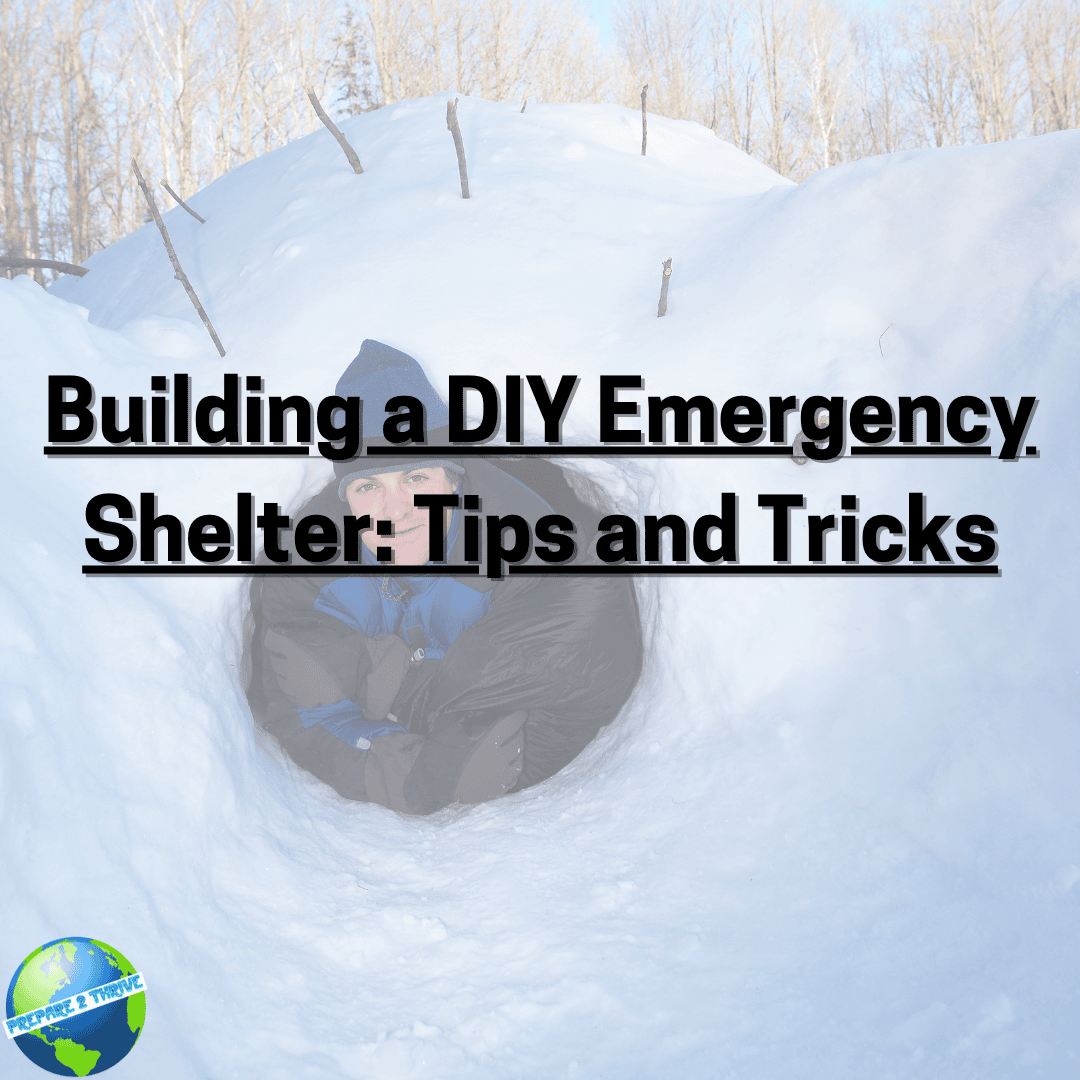1. Introduction
Emergencies can happen unexpectedly, and having a reliable shelter during such times is crucial. Whether you're preparing for natural disasters, camping adventures, or other unforeseen circumstances, building your own emergency shelter can provide a sense of security and self-sufficiency. In this blog article, we'll explore the tips and tricks for constructing a DIY emergency shelter.
2. Assessing Your Needs
Before embarking on your DIY shelter project, it's essential to assess your specific needs and requirements. Understanding the potential emergency scenarios you may encounter will help you design a shelter that suits those situations best.
Start by identifying the types of emergencies common in your area, such as hurricanes, floods, or extreme cold. This knowledge will enable you to plan for the specific challenges posed by each scenario. Consider the duration of the emergency and the number of people the shelter needs to accommodate. For short-term emergencies, a temporary shelter may suffice, while a semi-permanent structure might be more suitable for longer durations.
Additionally, take into account your location and climate. If you live in an area with heavy rainfall, sturdy waterproofing will be vital. In colder regions, insulation and heating solutions are essential to protect against freezing temperatures. Evaluating these factors will help you determine the materials, design, and features necessary for your DIY emergency shelter.
3. Planning and Preparation
Once you have assessed your needs, it's time to plan and prepare for your DIY emergency shelter project. This stage is crucial for ensuring a smooth and successful construction process.
Start by researching various shelter designs and materials. Look for designs that align with your requirements and available resources. Consider factors such as ease of construction, durability, and portability. Explore different materials such as tarpaulins, tents, or improvised structures made from available resources.
Creating a budget and timeline is essential to keep your project on track. Determine how much you are willing to spend on materials and tools, and set a realistic timeline for completion. This will help you prioritize tasks and make informed decisions during the construction process.
Gather all the necessary tools and resources before starting the project. This may include construction tools like hammers, saws, and ropes, as well as materials like lumber, nails, and waterproofing solutions. Having everything readily available will save time and prevent delays during construction.
4. Choosing the Right Shelter Design
Choosing the appropriate shelter design is crucial for meeting your specific needs and ensuring the functionality of your DIY emergency shelter.
Consider whether you require a temporary or semi-permanent shelter. Temporary shelters like tents or tarps are ideal for short-term emergencies and camping situations. They are usually lightweight, easy to assemble, and portable. On the other hand, semi-permanent shelters offer more durability and comfort for longer durations. They may involve more complex designs and construction processes.
Research pre-fabricated shelter options as well. These ready-made structures can save you time and effort, especially if you prefer a hassle-free solution. There are various pre-fabricated shelters available on the market designed specifically for emergency situations.
Weigh the pros and cons of each design option and choose the one that best fits your needs, budget, and skill level. Keep in mind factors such as assembly time, portability, durability, and adaptability to different weather conditions.
5. Essential Construction Techniques
Building a DIY emergency shelter requires employing essential construction techniques to ensure its stability, functionality, and protection.
Selecting a suitable site is crucial. Look for an elevated area away from potential hazards like flood zones or unstable terrain. Ensure the ground is level and clear of debris. Additionally, consider factors such as access to water sources and proximity to emergency services.
Anchoring and stability are important considerations. Depending on the type of shelter, use appropriate anchoring methods like stakes, ropes, or weights to secure it firmly to the ground. Reinforce the structure to withstand strong winds, heavy rainfall, or other extreme weather conditions.
Proper insulation and weatherproofing will enhance the comfort and protection of your shelter. Use insulating materials like foam panels or blankets to retain heat during cold weather. Ensure proper sealing of seams and openings to prevent water leakage. Waterproofing treatments and coatings can also be applied to materials like tarps or canvas to enhance their resistance to moisture.
6. Basic Supplies and Equipment
In addition to the shelter structure itself, it's important to consider the basic supplies and equipment necessary for a functional emergency shelter.
Think about sleeping arrangements and bedding. Sleeping bags, foam pads, or inflatable mattresses can provide comfort and insulation. Consider the number of people the shelter will accommodate and ensure you have enough sleeping arrangements for everyone.
Food and water storage is vital. Opt for non-perishable food items that are easy to store and require minimal preparation. Stock up on canned goods, dry goods, and emergency food kits. Have a sufficient supply of drinking water stored in clean, sealed containers. Also, consider water purification methods like water filters or purification tablets in case your water supply becomes contaminated.
Lighting and heating solutions are essential for safety and comfort. Battery-powered lanterns, flashlights, or solar-powered lights can provide illumination during dark hours. Consider portable heaters or alternative heating methods like camping stoves or fire pits, ensuring proper ventilation and safety precautions.
7. Tips for Safety and Security
When building a DIY emergency shelter, it's essential to prioritize safety and security to ensure the well-being of yourself and others in emergency situations.
Implement fire prevention and management strategies. Avoid open flames inside the shelter and use battery-operated or propane-powered devices for cooking or heating. Keep fire extinguishers readily available and learn proper fire safety protocols.
Protect the shelter from wildlife and insects. Seal any gaps or openings that may allow critters to enter. Use bug screens on windows or doors to keep insects out while ensuring proper ventilation.
Secure your shelter and belongings. Consider using locks or other security measures to prevent unauthorized access. Keep valuable items and important documents in waterproof containers or bags.
8. DIY Emergency Shelter Maintenance
Maintaining your DIY emergency shelter is crucial to ensure its long-term functionality and durability.
Regularly inspect your shelter for any signs of damage, wear, or degradation. Check for loose fastenings, torn materials, or weakened structural components. Repair or replace any faulty elements promptly to maintain the shelter's integrity.
Clean and sanitize your shelter regularly. Remove dirt, debris, and pests that may have accumulated. Use appropriate cleaning solutions and follow hygiene practices to prevent the spread of germs and diseases.
Proper storage and organization of supplies are essential for efficient use of the shelter. Keep food items properly sealed and stored in a cool, dry place. Maintain an inventory of your supplies and replenish them as needed.
9. Additional Considerations
While constructing a DIY emergency shelter, there are some additional considerations that can enhance your preparedness and overall safety.
Ensure you have a well-stocked first aid kit and necessary medical supplies. Include items like bandages, antiseptics, medications, and any specific medical equipment required for your family's needs. Familiarize yourself with basic first aid procedures and emergency medical protocols.
Establish a communication plan with your family or group. Determine a designated meeting point and develop a communication strategy in case of emergencies. Keep a portable, battery-powered or hand-cranked radio to stay informed about the latest updates and alerts.
Identify evacuation routes and alternate shelters. In certain emergency situations, it may be necessary to evacuate your DIY shelter. Research and plan multiple evacuation routes based on different scenarios. Identify nearby emergency shelters or community centers that can provide assistance if needed.
10. Conclusion
Building a DIY emergency shelter is a proactive step towards preparedness and self-reliance. By assessing your needs, planning carefully, and employing the right construction techniques, you can create a secure and functional shelter to weather unexpected situations.
Remember to prioritize safety and security, maintain your shelter regularly, and consider additional factors such as first aid, communication, and evacuation plans. With these tips and tricks, you'll be well-equipped to face emergencies confidently and protect yourself and your loved ones.
Hashtags: #DIYEmergencyShelter #EmergencyPreparedness #SelfReliance #ConstructionTips #ShelterDesign #SafetyandSecurity


